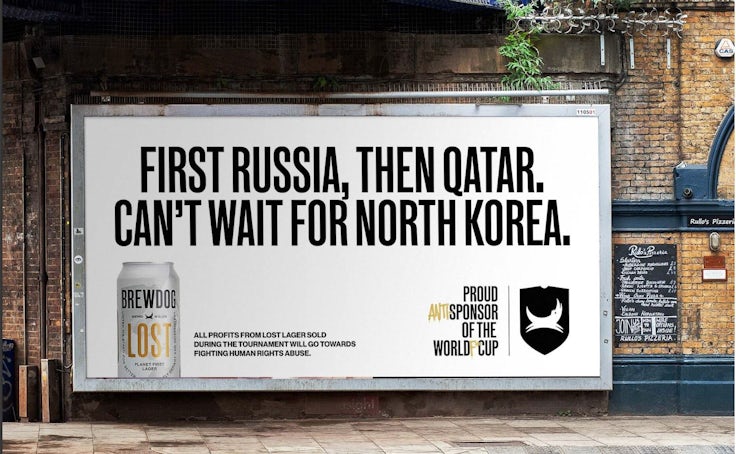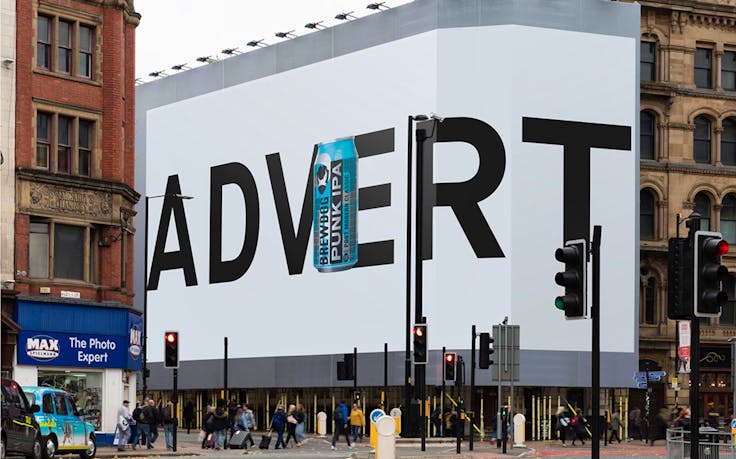A new marketing phase is resulting in empty but effective advertising
Those who criticise inauthentic advertising with no deeper meaning miss how perfect it is for making a brand stand out to a 21st-century consumer bombarded with information.

There is a rather splendid new long-form video ad for Belvedere doing the rounds this week.
We zoom in on the blonde, chiselled profile of Daniel Craig. The former 007 is wearing a white suit. Standing on the Pont Neuf. He looks out, impassive, across the water. Slowly he turns, locks eyes with the camera and stares straight down its barrel. It’s a moment that might say many things but a second later he is off, moving.
Craig climbs into a Rolls-Royce then climbs back out. He walks… hang on. Why am I bothering to tell you what happens next? You’ve already seen it. And if you haven’t, you will have in the next 24 hours. The ad is everywhere. Online. On news feeds. In the press. In Marketing Week columns. It has done that thing that all truly great advertising does: within a few short hours it has become culturally predominant.
But what does the ad actually mean? What is that initial look all about? What’s with the strange dancing? The 80s jacket? The DC jewellery? And what does it say about Belvedere? What is the link between Paris and the brand? Between brand and celebrity? Does Daniel Craig even drink Belvedere in real life? Will consumers care when he has endorsed so many other beverages in his celebrity past? Why does it end like that?
The answer to all these 20th-century questions is the same: it does not matter.
This is an ad made almost a quarter of a century into a new millennium and more than 30 years after David Aaker published Managing Brand Equity. It represents the current milieu perfectly.
It is an engaging, attractive, uber-cool slice of nothing. It is all about the signifiers. Not only is all signified meaning absent, it was never meant to signify anything in the first place. Director Taika Waititi, the king of slippery, empty semiosis, knows exactly what he is engineering. This is the fourth stage of Baudrillard’s simulacra writ large – a lack of any relation to reality. With Rita Ora on backing vocals.
Don’t make the mistake of thinking it’s a bad ad, however. Or one that won’t sell vodka. Neither criticism applies. Just because an ad is devoid of significance does not mean it will be devoid of impact – quite the opposite in 2022.
BrewDog faces backlash as World Cup ‘anti-sponsor’ stunt branded ‘disingenuous’
We live in a period where the search for meaning is relative, contested and oppositional. No one knows what anything means anymore. We also live in a time where presence, salience and even the briefest burst of attention is the highest marketing priority. With so many voices shouting at once, getting anyone to hear even a sentence is a valuable achievement.
Belvedere will win Christmas because it got people thinking – without any ultimate semantic goal – about Belvedere. Not necessarily deep thoughts. But some flicker of cognitive activity. And here is the catch. It is easier for Belvedere to achieve this vital superficial goal because its ad has no inherent meaning or any attempt at intended meaning. The freedom to spook the audience and play in the empty referent space of early 21st-century culture enables it to strike such a potent, vacuous note with its audience.
We are witnessing a new marketing moment, in which meaning and authenticity are traded for eyeballs and attention. It may not last forever but it is clearly a current opportunity.
Branding theory has changed much in the last 30 years. Partly as a function of a changed and fragmented media market. But also because we have learned the more basic manner in which brands work their magic on consumers. Summarising a big literature into one sentence, it’s more about salience than it is about image. Bring the brand to mind – among as many people, and as often, and as positively as possible – and you will win growth.
Now reverse that logic. Because it tells marketers not to sweat the position, the image or the depth they were trained to initially focus upon. That’s easier for Belvedere, which operates in a category that is the definition of emptiness.
Vodka is a drink that can be literally made from anything and which is meant to smell and taste of nothing. The ultimate hyperreality beverage. Anyone who tells you they have a ‘favourite vodka’ is writing ‘I know nothing’ in red lipstick across their forehead in wonky letters in front of you.
But this logic of salience above image applies to every category – B2B, B2C, services, SaaS and SME – and to a greater degree than most marketers thought possible. Partly because without salience there is no image. Partly because we overvalued image and undervalued salience for a marketing generation.
BrewDog puts salience above all
The maestros at BrewDog know all of this. And have known it for years. The brewery has two core competencies. First – and this is the one most marketers miss, because their altitude within their own anal cavity is too elevated – BrewDog makes beer that tastes great. Second, the brand aims for ongoing salience above all else, through a recurring series of stunts, shunts and various other endeavours.
Each is devoid of meaning, authenticity and often appreciation. But each maintains the brand’s position in the precarious consciousness of the beer-drinking mass market until the next empty caper is concocted. Tactical burning then reburning, just as the original embers grow cold, in a constant reignition of brand awareness.
BrewDog names its beers after drugs, weaponry and dead pets. It claims to be the planet’s favourite beer without an ounce of accuracy, concern or reticence. It offered 10 solid-gold beer cans in a contest that neglected to award even a single solid-gold beer can. To make up for this ‘error’ the brewery launched a new contest for the chance to win another gold beer can, this time diamond encrusted. None have yet surfaced. The brand’s advertising features the liberal use of fuck, motherfucker and giant 70ft high billboards saying simply ‘advert’.
Perhaps this last giant, empty billboard best exemplifies BrewDog’s approach and the current empty cyphers of successful 21st-century advertising. There is no meaning other than the celebration of the lack of it. But this vacant message attracts eyeballs and confers attention on the brand.
It is brilliant stuff and it is commercially effective. Name me another brewer that grew sales by 31% in 2021? And will probably do the same this year? BrewDog’s success makes a mockery of the marketing industry’s critique of its approach.
And the success and criticism will continue. An army of marketers are now lining up to savage BrewDog’s latest campaign. The new advertising work criticises the Qatar World Cup and promotes a new Lost Lager, which protests football’s biggest tournament being hosted by one of the world’s most regressive regimes. If you listen to marketers, this campaign will backfire because of the inconsistencies between this new campaign and the brand’s business operations.
The brand is still being exported to Qatar – gotcha! The brewery will still broadcast World Cup games live across its venues – fuckers! BrewDog is criticising Qatar for contractor deaths when its own employees claimed they worked in a “culture of fear” – hypocritical bastards! Burn them! Burn them!
 Marketers and the marketing press are missing the point. Because there is no point. You cannot skewer BrewDog over apparent inconsistencies between what the company says and what it does when it gives zero fucks about the gap in question. Neither do the beer drinking public, who like their beer cold and free from the posturing horseshit of modern marketing departments. And they are reminded of these two facts whenever Brewdog appears in outdoor ads, outraged posts or press reports of government sanction. Its marketing works. Better than most.
Marketers and the marketing press are missing the point. Because there is no point. You cannot skewer BrewDog over apparent inconsistencies between what the company says and what it does when it gives zero fucks about the gap in question. Neither do the beer drinking public, who like their beer cold and free from the posturing horseshit of modern marketing departments. And they are reminded of these two facts whenever Brewdog appears in outdoor ads, outraged posts or press reports of government sanction. Its marketing works. Better than most.
‘Punks with Purpose’ six months on: What’s the state of the BrewDog brand?
Let’s be honest. Most marketers are desperate to appear cool and righteous, even when that stance runs directly against their professional requirement to be market-oriented and expert at marketing. Most marketers read about co-founder James Watt being shitty to staff and decided this meant BrewDog’s marketing had to be publicly criticised and certain of imminent failure.
Maybe Watt was/is a bad boss. He won’t be the last. But he is an exceptional brand builder and our industry needs to be able to hold two conflicting ideas in its head at the same time. We aren’t the fucking Church of England. If it’s good marketing we need to say it’s good marketing.
It’s good marketing.
That’s a crucial observation, not only because we should venerate BrewDog, but because we also recognise the brand for being in the vanguard of emptier, more effective advertising. We are witnessing a new marketing moment, in which meaning and authenticity are traded for eyeballs and attention. It may not last forever but it is clearly a current opportunity.
Embrace emptiness
Unfortunately, too many brand managers are restricted in their ability to generate all-important salience because of their cowardly attraction to safe consistency, impossibly overstated significance in the lives of consumers and an implicit desire to posture around industry norms. They should free themselves. Take their shirt off and roll around in the quotidian dirt of consumer reality. Trade dozens of out-of-date barrels of authenticity, personality and depth for a few glasses of precious attention.
Trust me on this. You are reading the words of a ‘marketing expert’ who once wrote a column about his ass. And then won a PPA Award for it. The column. Not his ass.

I still believe brand image plays a role in purchase and price insensitivity. But the valence between generating awareness and brand-centric associations is not tilted to the latter anymore. Those days ended around 2005.
Despite whatever gotcha moment Marketing Twitter is trying to engineer online for BrewDog, it will only succeed in appearing out-of-touch with the market and marketing itself. The second shoe is not going to drop on BrewDog’s brand. It is pressed against the bar while its owner knocks back a pint of Dead Pony Club.
The game is empty salience. That’s partly because it’s a better strategic choice for a world filled with information and devoid of meaning, partly because of an exhausted post-Covid consumer that’s done enough soul-searching for one decade, partly because marketers now realise it was always way more important than any of us initially thought, and partly because whatever emerges from the reptile part of the brain is then rationalised by the monkey bits (I’m paraphrasing here) to arrive at purchase.
Modern marketing is still about symbolism. But the focus has moved from signified meaning to the brutal awareness of an arbitrary signifier and its ability to conjure the brand momentarily into consciousness. A dancing Daniel Craig means nothing, but will sell a shit-ton of vodka. BrewDog’s repudiation of Qatar 2022 is an empty, inconsistent, ultra-effective move. My arse lives forever in the annals of Marketing Week as a totem of my total absence of earnest intellectualism.
“Smile,” Baudrillard once wrote in his masterwork, America, “and others will smile back. Smile to show how transparent, how candid you are. Smile if you have nothing to say. Most of all, do not hide the fact you have nothing to say nor your total indifference to others. Let this emptiness, this profound indifference shine out spontaneously in your smile.”
Mark Ritson teaches a balance of image and salience on his Mini MBA in Marketing courses, and is a four time winner of the PPA Columnist of the Year for articles that don’t always feature his anatomy.







